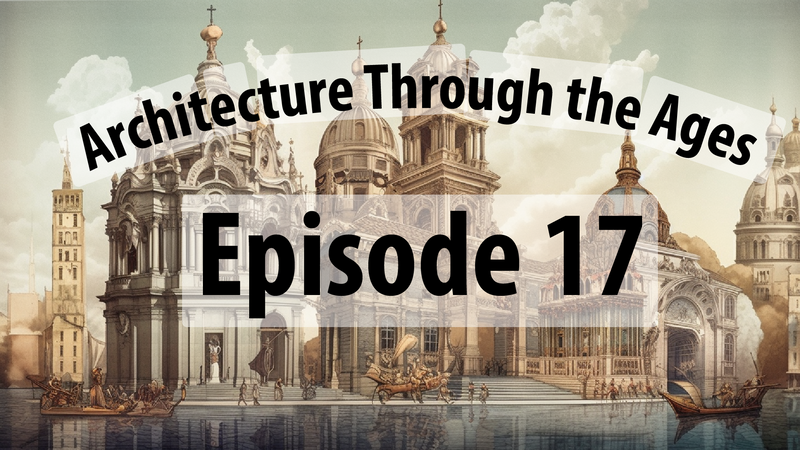Architecture Through the Ages: Challenging the Foundations of Design
Architecture, that grand intersection of art and utility, has played a defining role in human civilization. From the awe-inspiring pyramids of ancient Egypt to the soaring cathedrals of the Middle Ages and from the revolutionary modernist structures of the 20th century to the avant-garde experiments of today, architecture has shaped our environment and reflected our aspirations. First, however, it is essential to critically examine the conventional wisdom surrounding architectural design and challenge the assumptions that have long dictated its course. In this article, I will embark on a journey through the ages, unapologetically pursuing intellectual rigour, questioning established notions, and drawing upon historical references to shed light on the multifaceted nature of architecture.
The Classical Ideal: An Ersatz for Humanity
Conventional wisdom reveres classical architecture as the epitome of perfection and harmony. The Greek and Roman temples, with their stoic columns and rigid proportions, have been exalted as architectural ideals. Yet, is this ideal genuinely representative of human needs and desires? Are we to believe that our aspirations lie in strict adherence to symmetry and formalism?
Let us not forget that the ruling elites commissioned these grand structures as tributes to their power and wealth. Classical architecture imposed a hierarchy that reinforced social divisions. Most people lived in humble dwellings that lacked the grandeur and luxury of the temples. Should we then celebrate an architectural tradition that perpetuates inequality rather than challenging it?
Gothic Transcendence: A Lesson in Ambiguity
While classical architecture may have claimed to embody perfection, the Gothic cathedrals of the Middle Ages took a different approach. Their soaring spires and intricate vaults sought not to impose order but to evoke a sense of awe and mystery. These cathedrals were metaphysical journeys, guiding the soul upward toward the divine.
However, it is crucial to recognize that the transcendental experience of Gothic architecture was not accessible to all. The construction of these cathedrals required vast resources, often obtained through the exploitation of the peasantry. As a result, the peasants, burdened with labour and poverty, were left outside spiritual transcendence.
Furthermore, the emphasis on verticality and negating the earthly realm in Gothic architecture divorced humans from their natural environment. This alienation from the earthly plane would later be perpetuated by modernist architects, who sought to separate humans from nature entirely.

Modernist Fallacies: Form over Function
In the early 20th century, they brought about a radical shift in architectural philosophy with the advent of modernism. Architects like Le Corbusier and Walter Gropius championed functionalism. However, in their pursuit of efficiency and rationality, they neglected the crucial role of human experience.
Modernist architecture prioritized functionality and stark minimalism, often at the expense of human comfort and aesthetic pleasure. The infamous housing projects of the mid-20th century, such as Le Corbusier's Unité d'Habitation, reduced living spaces to soulless boxes devoid of individuality and warmth. These sterile environments failed to cater to their inhabitants' diverse needs and desires.
Moreover, the dogmatic adherence to the modernist ideology stifled architectural diversity and creativity. The utopian dream of universal solutions to societal problems proved to be an illusory panacea. Instead, architecture became a victim of its rigid principles, leading to the homogenization of our built environment and a loss of cultural identity.
Reimagining Architecture: Embracing Pluralism and Context
To move beyond the limitations of the past, we must challenge the conventional wisdom that has dictated architectural discourse. We must recognize that no singular "ideal" form or style can encompass the vast diversity of human experiences.
Architecture should not be a manifestation of power and control, nor should it alienate us from our natural surroundings. Instead, it should be a celebration of human creativity, embracing the complexities of our existence. We must prioritize the needs and aspirations of the people who inhabit these spaces and consider the context in which buildings are constructed.
By embracing pluralism in architectural design, we can create environments that cater to diverse cultural expressions, address social inequalities, and promote sustainability. In addition, we can draw inspiration from historical references and employ innovative technologies to forge a new path forward.
Martine's Take:
When we speak of the multifaceted nature of architecture, one would imagine reading about a mixture of architectural styles developing throughout the ages and worldwide. However, as with so many things in our modern society, we have been inspired by Western thought. Greek and Roman architectural elements keep reappearing throughout the ages - from the Renaissance to the Neo-Classical period - in the world of the West.
As the second commentator perfectly indicates, our Western architectural views are a 'narrow slice of the built world, both historically and culturally.'' As an ancient historian, I see this in my field more regularly: Scholars in the Western world focus on discussing our Greek and Roman legacy, while sometimes Egypt and Mesopotamia are discussed as well, but that is all. Other ancient cultures, like in America and Australia (pre-colonial) or Asia, are hardly discussed.
Yet, we become more interested in non-western cultural elements (including in non-western architecture), we will be able to understand relationships between countries better, and we will see aspects of building styles appear in other non-western parts of the world.
Several years ago, when I was on holiday in Mexico (coming from The Netherlands; studying in The Netherlands and the UK), I visited the temples and the palace of Teotihuacan. Here I saw architectural elements that I had also seen at the court of Knossos of Greece (materials, building techniques, painting techniques). The palace of Knossos was built around 1900 BC, while the great pyramids of Teotihuacan were completed around 100 CE. So, 2000 years after the Knossos palace was built, similar building techniques were used in Mexico, long before the first Europeans came to America. Yet, still, there seems to be some connection between the two sites. I do not know what exactly this is since I am unfortunately not an expert on Meso-American ancient architecture. Still, maybe one day, we will learn more about the relationships between architectural styles worldwide.
To do so, western scholars should become more interested in non-western cultures in general, and in this case, specifically in the architecture of these cultures. In doing so, we can better understand how architectural elements were created and developed over time at different places in the world and how these elements relate to each other.
J.C.'s Take:
The cursory analysis of the three phases of architectural ideology and the intentions and corollary results is interesting in its critique. Still, it points out another fundamental and perhaps equally critical issue, which is that Western thought (and as a graduate architectural historian), which thought was taught to be dominant, is a narrow slice of the built world, historically, culturally and as a measure of how people live and have built structures on this earth.
- The point that residential buildings were overlooked is accurate, but equally important is that entire cultures and ethnology are regularly ignored in architectural theory.
- I got a university degree from a good school while learning almost nothing about Asian, African or indigenous architecture.
- We studied Egyptian pyramids but not Mayan, Greek temples but not Angor Wat, and Corbusier's urban planning but not Timbuktoo.
- I agree that architectural theory needs a rethink, and my current focus is on natural, local and traditional built forms, both internationally and historically.
- We can learn much from studying what people have done for their shelter; how, where, when and why.
Conclusion
As we journey through the ages of architecture, it becomes clear that there is no singular path to follow. Instead, we must critically examine the foundations of design and challenge the conventional wisdom that has limited our understanding of architecture's potential.
Let us reject the dogmas of the past and embrace a new era of architectural pluralism—one that prioritizes human experience, fosters inclusivity, and engages with our natural environment. By doing so, we can create spaces that inspire, uplift, and truly resonate with humanity's diverse needs and aspirations.


